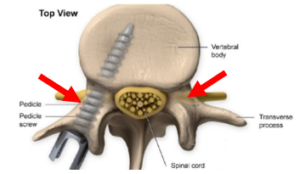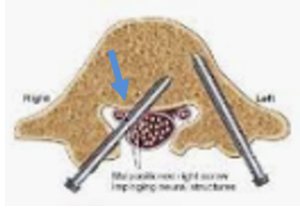By: Stephen Saris, M.D.
 What is a pedicle screw malposition?
What is a pedicle screw malposition?
Pedicle screws are used by spine surgeons as part of a fusion in which two adjacent bones in the spine are combined together as one. The intent is to provide relief from pain and nerve damage. One of the common means of doing so is to place a screw into each of two adjacent spinal bones (vertebrae), and then a rod between them. The screw passes through a part of the bone called the pedicle (red arrows). When the screw is positioned poorly, it can compress or pass through a nerve (blue arrow) causing permanent damage.
What are the symptoms of a screw malposition?
In these instances, the patient awakens from surgery with severe pain traveling down one leg. This is associated with nerve damage such as weakness of a muscle or numbness in part of the leg. Clinical suspicion in this situation becomes high for pedicle screw malposition, and an urgent CAT scan is warranted.

Clinically relevant complications related to pedicle screw placement in thoracolumbar surgery and their management: a literature review of 35,630 pedicle screws, Oliver P. Gautschi M.D. https://doi.org/10.3171/2011.7.FOCUS11168
Incidence and risk factors for the misplacement of pedicle screws in scoliosis surgery-analysis of a large series of one thousand, one hundred and forty five screws. Jin M. Int Orthop. 2017 Apr;41(4):773-780. doi: 10.1007/s00264-016-3353-6. Epub 2016 Dec 21.
What is the treatment of this condition?
Treatment usually involves going back to the operating room to remove and reposition the screw. Unfortunately, the nerve does not always recover even in spite of this corrective intervention. This can result in permanent pain and nerve damage.
What are the potential risks of litigation regarding malposition of a pedicle screw?
There are numerous techniques and devices used to minimize the chance of a screw malposition and nerve injury. Amongst these are O ARM (below right), robotic devices (below left), C-Arm fluoroscopy, and intraoperative electrical monitoring. In spite of these available prevention techniques, screw malposition is unfortunately not an uncommon occurrence (6% in the Oliver, et al, article). Pedicle screw malposition is the source of frequent litigation.
Conclusion
A pedicle screw expert witness knowledgeable about the reasons for screw malposition may be a valuable resource during litigation where pedicle screw malposition is alleged. Opinions rendered by a neurosurgery pedicle screw expert witness may address whether or not the standard of care was met, and whether harm was caused to the plaintiff.
Stephen C. Saris, MD is a board-certified neurosurgeon who practices in both Rhode Island and Massachusetts. His practice involves both brain and spine surgery. Dr. Saris trained at Harvard and Duke. He is currently on the faculty of both Harvard and Rhode Island Hospital. Dr. Saris is a highly experienced expert witness who has given more than 500 depositions and appeared in court more than 50 times.
Office: (401) 453-3545 * Fax: (401) 453-3533 * Cell: (401) 378-2921
Email: ssaris@bwh.harvard.edu * Website: www.neurosurgery-associates.com







